
In the severely damaged prefectures of Iwate, Miyagi and Fukushima in Japan, at least 125 children and students were killed and 1,600 remained missing following the March 11 disaster, authorities said.
As fuel shortage made it difficult to cremate the bodies, two municipalities in Miyagi Prefecture -- Higashimatsushima and Watari -- started burying them after gaining consent from the families. Nine other municipalities in Miyagi as well as Kamaishi and Otsuchi in Iwate prefecture will follow suit, Kyodo said.
...
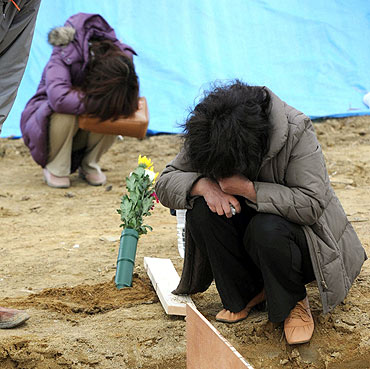
In Higashimatsushima, 24 bodies were buried on Tuesday, with many of them wrapped in sheets as there were not enough coffins. Four bodies were buried at a temple in Watari. The Higashimatsushima city government said it has marked a large portion of land for the burial of up to 1,000 bodies.
Two other municipalities planned to cremate the bodies, probably within two years, officials were quoted as saying.
...
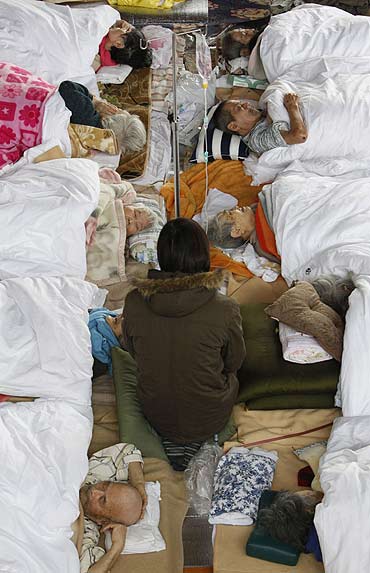
A total of 270,000 evacuees, including those who fled areas around the crisis-hit nuclear plant, were now staying at nearly 1,900 shelters in 16 prefectures.
The prefectural government of Osaka started accepting applications from the evacuees for its public housing which will be offered for free, while Nagasaki prefecture authorities said they have decided to accommodate nearly 1,700 evacuees at private hotels and hot spring inns for up to two months without any charge.
Japanese workers scrambled hard to restore power at the troubled Fukushima nuclear plant as smoke rose from two of its reactors in tsunami-hit northeast, which was jolted by a series of new powerful quakes, including two measuring 6.6 on the Richter Scale.
...
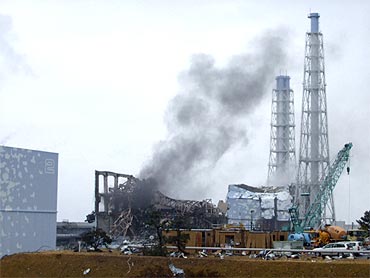
Authorities sought the help of the United States military in tackling the "extremely tough" situation at the plant. Highly concentrated radioactivity was detected in iodine and cesium in seawater near the plant, sparking fears about food safety.
The nuclear plant's operator, Tokyo Electric Power Company, said the seawater pollution in the region had expanded, but the country's nuclear safety agency said there were no immediate health threats.
Emergency workers battled to avert a widespread disaster by trying to reconnect power lines and cool overheating reactors.
...

The critical restoration work at the plant was stalled on Monday after smoke rose from No.2 and No.3 reactors, fuelling fears of fresh radiation leaks from the area rocked by the March 11 quake of magnitude 9 and devastating tsunami that left over 22,000 people dead or unaccounted for in Japan's northeast.
Although white smoke, possibly steam, was still found to be billowing from the No.2 and No.3 reactors, TEPCO said it was not obstructing electricity restoration work.
Fire-fighters and Self-Defense Forces personnel were also ready to restart their mission to spray tonnes of coolant water onto spent nuclear fuel pools at the No.3 and No.4 reactors, according to TEPCO.
...

The US Geological Survey, meanwhile, said that two 6.6-magnitude quakes and one measuring 6.4 on the Richter Scale were reported within two and a half hours off Japan's north-eastern Honshu coast, starting from 12.48 IST.
However, there were no reports of casualties or damage. Japan's National Police Agency said the number of those killed or were missing following the devastating March 11 earthquake and tsunami topped 22,000.
It said the death toll reached 9,080 in 12 prefectures, while 13,561 people remained missing in six prefectures.
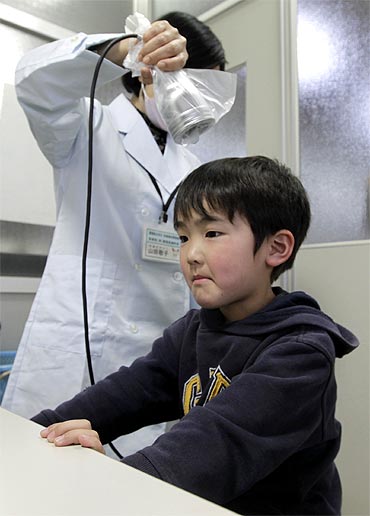
On the nuclear crisis, Defence Minister Toshimi Kitazawa said the smoke rising from the No.2 reactor at the Fukushima plant were vapours caused by water-discharging operations. He said the blackish smoke was detected on Monday at No.3 reactor as some rubble had caught fire after a rise in temperature.
Japanese defence authorities have also sought support of the US military to jointly tackle the ongoing nuclear crisis, Kitazawa said.
SDF helicopters will begin measuring "drastically changing" temperatures at the plant daily except for rainy days to "relieve people's concerns," instead of the earlier planned twice a week, he said.

An external power source was connected to the No.4 reactor on Tuesday morning, making it the fifth of the plant's six reactors to have regained the power supply needed for the restoration of a ventilation system to filter radioactive substances from the air, Kyodo said.
Following the powerful quake and tsunami, the cooling functions failed at the No.1, No.2 and No.3 reactors and their cores are believed to have partially melted. Industry Minister Banri Kaieda said separately that the situation remained "extremely" tough.
"It is difficult to say that things are showing progress...," he was quoted as saying.

Prime Minister Naoto Kan had on Monday said that slow but "steady progress" is being made in tackling the brewing crisis at the quake-hit power plant.
TEPCO, meanwhile, began studying the crisis's impact on the sea after detecting highly concentrated radioactive substances near the Fukushima plant's water discharging outlets.
The International Atomic Energy Agency also said the Japanese authorities have reported that they will measure radioactivity in the marine environment around the Fukushima plant.
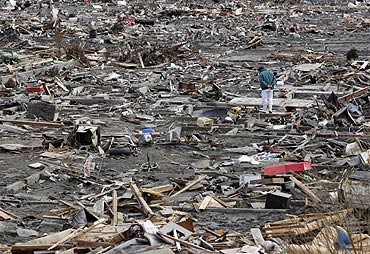
The monitoring will be done by the Japan Agency for Marine-Earth Science and Technology, results of which will be provided on Thursday, it said.
The Japanese government may need to create three different supplementary budgets for fiscal 2011 to finance reconstruction work after the devastating earthquake, National Policy Minister Koichiro Gemba said.
"Damage is widespread. (Drawing extra budgets) twice will likely not be sufficient," Gemba was quoted as saying by Kyodo after a Cabinet meeting.